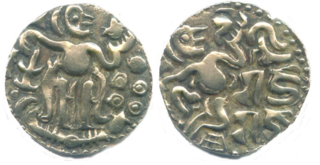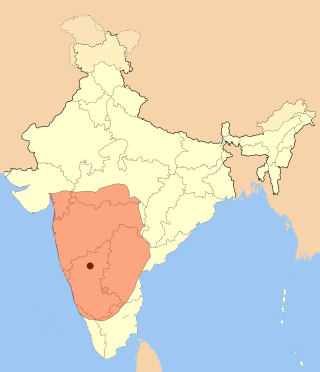Related Research Articles

The Pandyan dynasty, also referred to as the Pandyas of Madurai, was an ancient Tamil dynasty of South India, and among the four great kingdoms of Tamilakam, the other three being the Pallavas, the Cholas and the Cheras. Existing since at least the 4th to 3rd centuries BCE, the dynasty passed through two periods of imperial dominance, the 6th to 10th centuries CE, and under the 'Later Pandyas'. Under Jatavarman Sundara Pandyan I and Maravarman Kulasekara Pandyan I, the Pandyas ruled extensive territories including regions of present-day South India and northern Sri Lanka through vassal states subject to Madurai.

The Pallava dynasty existed from 275 CE to 897 CE, ruling a significant portion of the Deccan, also known as Tondaimandalam. The Pallavas played a crucial role in shaping in particular southern Indian history and heritage. The dynasty rose to prominence after the downfall of the Satavahana Empire, whom they had formerly served as feudatories.

Vikramaditya II was the son of King Vijayaditya and ascended the Badami Chalukya throne following the death of his father. This information comes from the Lakshmeshwar inscriptions in Kannada dated 13 January 735 A.D. From inscriptions it has come to be known that even before his coronation, Vikramaditya II, as a crown prince (Yuvaraja), had conducted successful military campaigns against their arch enemy, the Pallavas of Kanchipuram. His most important achievements were the capture of Kanchipuram on three occasions, the first time as a crown prince, the second time as an emperor and the third time under the leadership of his son and crown prince Kirtivarman II. This is attested to by another Kannada inscription, known as the Virupaksha Temple inscription which alludes to the emperor as the conqueror of Kanchi on three occasions and reads Sri Vikramaditya-bhatarar-mume-Kanchiyan-mume parajisidor. The other notable achievement was the consecration of the famous Virupaksha Temple and Mallikarjuna Temple by his queens Lokadevi and Trilokadevi at Pattadakal. These two monuments are the centre piece of the UNESCO World Heritage Monuments at Pattadakal. Vikramaditya II was a powerful ruler and was in power for 40 years. In order to maintain peace he entered into marriage alliance with Rashtrakutas.

Kulottunga I also spelt Kulothunga, born Rajendra Chalukya, was a Chola Emperor who reigned from 1070 CE to 1122 CE succeeding his cousin Athirajendra Chola. He also served as the Eastern Chalukya monarch from 1061 CE to 1118 CE, succeeding his father Rajaraja Narendra. He is related to the Chola dynasty through his mother's side and the Eastern Chalukyas through his father's side. His mother, Ammangaidevi, was a Chola princess and the daughter of emperor Rajendra I. His father was king Rajaraja Narendra of the Eastern Chalukya dynasty who was the nephew of Rajendra and maternal grandson of Rajaraja I. According to historian Sailendra Nath Sen, his accession marked the beginning of a new era and ushered in a period of internal peace and benevolent administration.

Aditya Chola I, the son of Vijayalaya Chola, was the Chola king who laid the foundation of the Chola Empire with the conquest of the Pallava Kingdom and the occupation of the Western Ganga Kingdom and Kongu Nadu. Aditya Chola I was succeeded by his eldest son Parantaka Chola I.

Rajadhiraja I was a Chola emperor, as the successor of his father, Rajendra I. He was the only Chola emperor who was killed while leading his army in war, and although he had a short reign, he helped his father conquer several territories as well as to maintain the Chola authority over most of Sri Lanka, Eastern Chalukya and Kalinga, among others. He also established imperial relations with overseas allies despite a series of revolts in the territory.

Amoghavarsha I was the greatest emperor of the Rashtrakuta dynasty, and one of the most notable monarchs of Ancient India. His reign of 64 years is one of the longest precisely dated monarchical reigns on record. Many Kannada and Sanskrit scholars prospered during his rule, including the great Indian mathematician Mahaviracharya who wrote Ganita-sara-samgraha, Jinasena, Virasena, Shakatayan and Sri Vijaya.
Pulakeshin II popularly known as Immadi Pulakeshi, was the greatest Chalukyan Emperor who reigned from Vatapi. During his reign, the Chalukya Empire expanded to cover most of the Deccan region in peninsular India.

Vijayalaya Chola was a descendant of the Early Cholas, who revived the Chola dynasty and founded the Imperial Chola Empire. He ruled over the region to the north of the river Kaveri. He is one of the descendants of the famous Sangam age Chola king, Karikala Chola. According to the Anbil plates of Parantaka Chola II, his predecessor is Srikantha Choladhiraja, a Telugu Chola king who ruled the Renadu region, belongs to the Pottapi Chola lineage, and is a descendant of the ancient Tamil king, Karikala Chola. Vijayalaya was succeeded by his son Aditya Chola I who laid the foundation of the Imperial Chola Empire.

The Kalabhra dynasty, also called Kaḷabrar, Kaḷappirar, Kallupura or Kalvar, were rulers of all or parts of Tamil region sometime between the 3rd century and 6th century CE, after the ancient dynasties of the early Cholas, the early Pandyas and Chera. Information about the origin and reign of the Kalabhras is uncertain and scarce. It is believed by historians that the Kalabhras belonged to the Vellalar community of warriors who were possibly once the feudatories of the Cholas and the Pallavas. Their proposed roots vary from southeast region of modern Karnataka, Kalappalars of Vellalar community, to Kalavar chieftains. This age is generally called "The Augustan age of Tamil Literature", in a 1922 book by the name "Studies in South Indian Jainism" written by M. S. Ramaswami Ayyangar and B. Seshagiri Rao. The Kalabhra era is sometimes referred to as the "dark period" of Tamil history, and information about it is generally inferred from any mentions in the literature and inscriptions that are dated many centuries after their era ended.

Rajendra II often referred to as Rajendradeva Chola was a Chola emperor who reigned from 1052 CE to 1064 CE. Rajendra II succeeded his brother Rajadhiraja I after his death at the Battle of Koppam. Rajendra had served as a Co-regent under his brother from 1044 CE to 1052 CE. When he acceded the throne, the Chola Empire was at its peak stretching from Southern India to Vengai(Bengal) to parts of Southeast Asia. Rajendra has maintained the territories of his predecessor. During his reign, the Chola Empire was prosperous and had a large influence in trade throughout the Indian Ocean.

Virarajendra was a Chola emperor, who spent a major part of his life as a subordinate to two of his elder brothers Rajadhiraja I and Rajendra II, he is the son of Rajendra I. During his early reign he granted the maintenance of a school to study the Vedas, Sastras and grammar; a hostel was provided for the students. A hospital named Virasolan was also provided by him for the sick people. The famous grammatical work in Tamil, Virasoliyam was written by Buddhamitra during his reign.
Kirttivarman I was a ruler of the Chalukya dynasty of Vatapi in India. He ruled parts of present-day Karnataka, Goa, Maharashtra and Andhra Pradesh.

Vikrama Chola, known as Kō Parakēsari Varman, was a 12th-century ruler of the Chola Empire in southern India. He succeeded his father Kulothunga I to the throne. Vikrama Chola was crowned as the heir-apparent by his father early in his life. He was appointed as viceroy of the Vengi province in 1089 C.E., succeeding his brother Rajaraja Chodaganga. Vikrama during his tenure successfully managed to check the ambitions of the Western Chalukya Vikramaditya VI on the Vengi kingdom.Vikrama Chola inherited the territories which included Tamil Nadu and some parts of Andhra Pradesh.

Eastern Chalukyas, also known as the Chalukyas of Vengi, were a dynasty that ruled parts of South India between the 7th and 12th centuries. They started out as governors of the Chalukyas of Badami in the Deccan region. Subsequently, they became a sovereign power, and ruled the Vengi region of present-day Andhra Pradesh until c. 1001 CE. They continued ruling the region as feudatories of the Medieval Cholas until 1189 CE.
Vikramaditya I was the third son and followed his father, Pulakeshi II on to the Chalukya throne. He restored order in the fractured empire and made the Pallavas retreat from the capital Vatapi.
Vijayaditya followed his father, Vinayaditya on to the Chalukya throne. His long reign was marked by general peace and prosperity. Vijayaditya also built a number of temples. He fought against the Pallavas and extracted tributes from Paramesvaravarman II. The Alupas of South Canara who were loyal to the Chalukyas and led by Alupa Chitravahana, brother-in-law of Vijayaditya defeated a Pandyan invasion of Mangalore in 705. Vijayaditya was succeeded by his son Vikramaditya II in 733. Vijayaditya ruled for 18 years.
Arikesari Maravarman, also known as Parankusa, was a Pandya king of early medieval south India.

The Chalukya dynasty was a Classical Indian dynasty that ruled large parts of southern and central India between the 6th and the 12th centuries. During this period, they ruled as three related yet individual dynasties. The earliest dynasty, known as the "Badami Chalukyas", ruled from Vatapi from the middle of the 6th century. The Badami Chalukyas began to assert their independence at the decline of the Kadamba kingdom of Banavasi and rapidly rose to prominence during the reign of Pulakeshin II. After the death of Pulakeshin II, the Eastern Chalukyas became an independent kingdom in the eastern Deccan. They ruled from Vengi until about the 11th century. In the western Deccan, the rise of the Rashtrakutas in the middle of the 8th century eclipsed the Chalukyas of Badami before being revived by their descendants, the Western Chalukyas, in the late 10th century. These Western Chalukyas ruled from Kalyani until the end of the 12th century.

Kongu Chera dynasty, or Cheras of Kongu or Karur, or simply as the Chera dynasty, were a medieval royal lineage in south India, initially ruling over western Tamil Nadu and central Kerala. The headquarters of the Kongu Cheras was located at Karur in central Tamil Nadu. The Chera rulers of Kongu were subordinate to or conquered by Pallava, Pandya and Chola rulers are also said to have overrun the Kongu Chera country.
References
Citations
- ↑ Narayanan, M. G. S. Perumāḷs of Kerala: Brahmin Oligarchy and Ritual Monarchy: Political and Social Conditions of Kerala Under the Cēra Perumāḷs of Makōtai (c. AD 800 - AD 1124). Thrissur (Kerala): CosmoBooks, 2013. 90. 103.
- ↑ Ram Bhushan Prasad Singh 2008, p. 83.
Sources
- Dr. Suryanath U. Kamat (2001). Concise History of Karnataka, MCC, Bangalore (Reprinted 2002).
- Nilakanta Sastri, K.A. (1935). The CōĻas, University of Madras, Madras (Reprinted 1984).
- Nilakanta Sastri, K.A. (1955). A History of South India, OUP, New Delhi (Reprinted 2002).
- Singh, Ram Bhushan Prasad (2008) [1975], Jainism in Early Medieval Karnataka, Motilal Banarsidass, ISBN 978-81-208-3323-4
- South Indian Inscriptions - http://www.whatisindia.com/inscriptions/
- History of Karnataka, Mr. Arthikaje